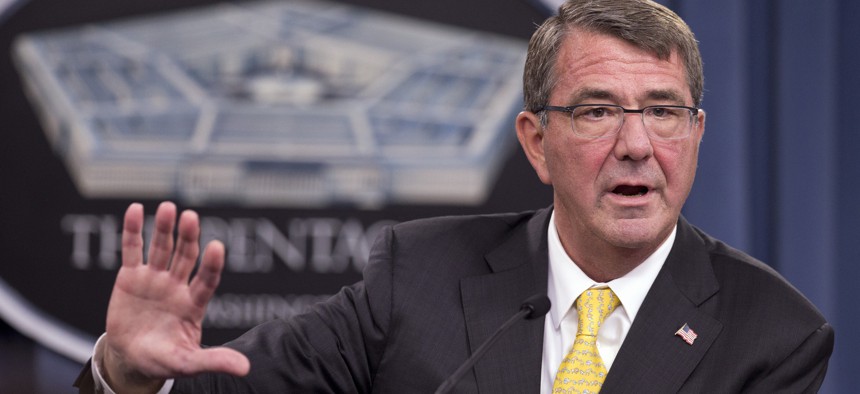
Defense Secretary Ash Carter speaks during a news conference at the Pentagon, Thursday, Aug. 20, 2015. AP Photo/Manuel Balce Ceneta
Pentagon Civilian Worker Reclassification Draws Fire
Union calls the plan "vague, non-specific, and often conflicting."
A Defense Department draft document aimed at bringing a World War II-era personnel system into the information age would reclassify thousands of civilian workers, moving them outside of the traditional civil service system and prompting the government’s largest employee union to denounce the plan as a violation of employees’ rights and merit-system fundamentals.
The Pentagon’s “Force of the Future” set of hiring and management reforms, requested by Defense Secretary Ash Carter, would move much of the “non-bargaining-unit civilian workforce from Title 5 [of the U.S. Code] to Title 10, for all personnel management actions, including hiring, determining compensation, managing performance and promotion,” according to a draft obtained by Government Executive.
Two-thirds of the Defense Department’s civilian workforce is currently hired and managed under Title 5 competitive service authorities, the memo stated. Those authorities -- governed by the Office of Personnel Management – apply to much of the federal civilian workforce, though certain agencies including the Commerce Department, the National Science Foundation, NASA and the Federal Deposit Insurance Corp. have received exemptions, according to the Defense plan.
“The current Title 5 General Schedule (GS) personnel system is outdated, rigid and representative of a workforce demographic from more than 60 years ago,” the document stated. “Although the current federal personnel management system is based on important core principles, those principles are operationalized in an inflexible, one-size-fits-all-system of defining work, hiring staff, managing people, assessing and rewarding performance, and advancing personnel. These inherent weaknesses make support of DoD’s mission complex, costly and ultimately risky.”
The new plan would give the Defense secretary hiring and management flexibility for 15 percent to 20 percent of the workforce that currently falls under Title 5 and OPM rules, the document said. It did not spell out a new personnel system for those employees, but said the Defense chief should have the power to establish one that fits the department’s needs.
“Unable to recruit top-tier talent,” supervisors express concern about the talent that ultimately comes onboard, said the draft, which combines legislative and executive branch proposals related to simplifying Defense’s 66 civilian personnel systems. “This reform will enable more efficient, effective, and necessary decisions on how Department of Defense personnel are managed,” the document stated.
Brad Carson, acting Defense personnel and readiness chief, is spearheading the project. In a recent television interview for Defense News, Carson described Force of the Future as “a strategic imperative” more than an efficiency measure. He expressed hope that it will be implemented by the end of the Obama administration.
On Tuesday, AFGE National President J. David Cox issued a statement blasting the plan as a “retread of failed policies from the Bush administration," a reference to the Pentagon’s short-lived post- 9/11 National Security Personnel System. “The Department of Defense is spinning these proposals as the ‘Force of the Future,’ but they are nothing more than a bad flashback,” Cox said.
That experimental system “was so discriminatory and harmful to the workforce that it was repealed by Congress less than two years after taking effect,” Cox said.
AFGE particularly objected to the proposed shift of employees from civilian-oriented Title 5 to military-oriented Title 10. The union said the plan “is filled with vague, non-specific and often conflicting statements about how this change would apply to the workforce and which employees would be affected.”
Though the union continues to study the plan for potentially positive features, “it is clear this move would give the current Defense secretary and any future secretary a blank check to craft a personnel system that could easily undermine and violate the fundamental principles of our long-established commitment to a merit-based civil service system,” AFGE stated.
Defense Department spokesman Matthew Allen, in an email to Government Executive, said federal employee unions have been consulted during the plan’s development since it was submitted in early August.
“The Department is looking at how we can best change and adapt, to remain competitive well into the 21st century,” Allen said. “This includes how we attract, develop and support the department's most valuable asset--its people. The department shared draft proposals focused on the civilian workforce, the scope of which emphasized innovation and technology, career flexibility, process efficiency and diversity.”
In compliance with President Obama’s executive order establishing labor-management forums to review pre-decisional directives, Allen added, the department is “seeking the full breadth of input from labor, in order to shape the personnel reform that will drive the Force of the Future.”He stressed that none of the proposals has been approved by Secretary Carter, who is scheduled to receive the latest draft this fall after the service secretaries and Joint Chiefs weigh in. The final plan will be incorporated into the Pentagon’s fall program and budget review.
“The reform proposals entail a broad range of topics,” Allen said, including “initiatives as simple as expanding child care hours and as complex as repealing parts of the Defense Officer Personnel Management Act.”
